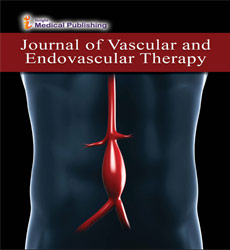Correlation of Arterial Calcification Patterns with Clinical Outcomes in Peripheral Arterial Disease Patients Undergoing Endovascular Therapy
Shen Jiang*
Department of Vascular Surgery, The First Hospital of China Medical University, Shenyang, China
Published Date: 2024-02-12DOI10.36648/2634-7156.9.1.180
Shen Jiang*
Department of Vascular Surgery, The First Hospital of China Medical University, Shenyang, China
- *Corresponding Author:
- Shen Jiang
Department of Vascular Surgery,
The First Hospital of China Medical University, Shenyang,
China,
E-mail: jiang@gmail.com
Received date: January 10, 2024, Manuscript No. IPJVES-24-18867; Editor assigned date: January 12, 2024, PreQC No. IPJVES-24-18867 (PQ); Reviewed date: January 26, 2024, QC No. IPJVES-24-18867; Revised date: February 05, 2024, Manuscript No. IPJVES-24-18867 (R); Published date: February 12, 2024, DOI: 10.36648/2634-7156.9.1.180
Citation: Jiang S (2024) Correlation of Arterial Calcification Patterns with Clinical Outcomes in Peripheral Arterial Disease Patients Undergoing Endovascular Therapy. J Vasc Endovasc Therapy Vol.9 No.1:180.
Description
Peripheral Arterial Disease (PAD) is a prevalent vascular condition characterized by atherosclerotic occlusive disease in the lower extremities, leading to reduced blood flow and ischemic symptoms. Endovascular Therapy (EVT) has emerged as a crucial treatment modality for PAD, offering significant benefits in improving limb perfusion and relieving symptoms. However, the presence and distribution of arterial calcification, particularly Intimal Arterial Calcification (IAC) and Medial Arterial Calcification (MAC), may influence treatment outcomes and prognosis in PAD patients undergoing EVT. A recent singlecenter retrospective study aimed to investigate the potential correlation between arterial calcification patterns and clinical outcomes following EVT in patients with PAD. The study, comprising 154 consecutively hospitalized individuals with PAD who underwent EVT for de novo femoral-popliteal calcific lesions between January 2016 and July 2021, employed a semiquantitative computed tomography scoring system to assess the predominant calcification patterns of IAC and MAC.
Clinical endpoints
The findings of the study revealed intriguing insights into the relationship between arterial calcification patterns and mediumto long-term outcomes post-EVT. Utilizing the Kaplan-Meier method and Cox regression analysis, the researchers evaluated the associations between calcification patterns and various clinical endpoints, shedding light on the prognostic significance of calcification in PAD patients undergoing EVT. One of the key observations of the study was the potential impact of arterial calcification patterns on procedural success rates and patency outcomes following EVT. Specifically, the presence of extensive IAC or MAC was associated with a higher risk of procedural complications, including suboptimal revascularization and vessel recoil, leading to decreased limb salvage rates and increased rates of Target Lesion Revascularization (TLR) during the followup period. Moreover, the study elucidated the potential influence of arterial calcification patterns on limb-related clinical outcomes, such as amputation-free survival and freedom from Major Adverse Limb Events (MALE). Patients with extensive IAC or MAC demonstrated inferior limb-related outcomes, highlighting the importance of considering calcification patterns in risk stratification and treatment decision-making for PAD patients undergoing EVT. Overall, the study underscores the significance of assessing arterial calcification patterns in PAD patients undergoing EVT and emphasizes the need for personalized treatment strategies tailored to individual calcification profiles. By elucidating the relationship between calcification patterns and clinical outcomes, this research contributes to optimizing patient care and enhancing treatment efficacy in the management of PAD.
Revascularization outcomes
Furthermore, the study's findings have implications for risk assessment and treatment planning in clinical practice. Clinicians managing PAD patients undergoing EVT may benefit from incorporating assessments of arterial calcification patterns into their pre-procedural evaluations. By identifying patients with extensive IAC or MAC, healthcare providers can anticipate potential procedural challenges and adopt tailored strategies to optimize revascularization outcomes. Moreover, the study underscores the importance of ongoing surveillance and followup care in PAD patients with significant arterial calcification. Close monitoring of limb perfusion, symptomatology, and patency status is warranted in patients with extensive calcification, as they may be at heightened risk of adverse limb events and revascularization procedures. Additionally, the study highlights the need for further research into the underlying mechanisms linking arterial calcification patterns to treatment outcomes in PAD patients undergoing EVT. Elucidating the pathophysiological pathways involved in calcification-related complications may facilitate the development of targeted therapeutic interventions aimed at mitigating the adverse effects of arterial calcification on procedural success and long-term prognosis. Overall, the study provides valuable insights into the complex interplay between arterial calcification patterns and clinical outcomes in PAD patients undergoing EVT. By incorporating these findings into clinical practice, healthcare providers can enhance risk stratification, optimize treatment strategies, and improve patient outcomes in the management of PAD.
Open Access Journals
- Aquaculture & Veterinary Science
- Chemistry & Chemical Sciences
- Clinical Sciences
- Engineering
- General Science
- Genetics & Molecular Biology
- Health Care & Nursing
- Immunology & Microbiology
- Materials Science
- Mathematics & Physics
- Medical Sciences
- Neurology & Psychiatry
- Oncology & Cancer Science
- Pharmaceutical Sciences
